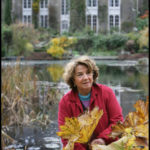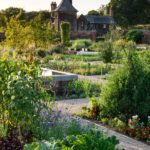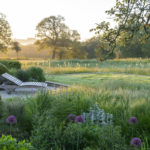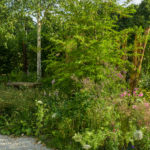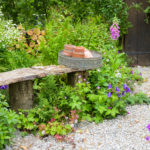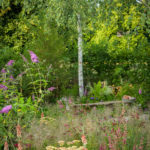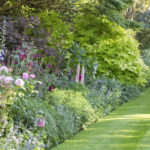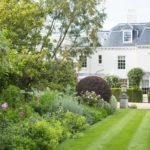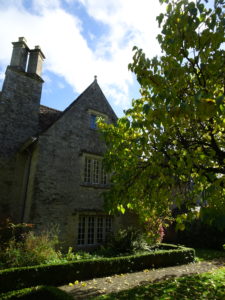Buckinghamshire Gardens Trust has for a number of years supported
International Women’s Day.
In 2022 we featured Forgotten Buckinghamshire Women in Gardening: Margaret Ursula Mee ( 1909-1988), Alice de Rothschild (1847-1922) and Kay Naylor Sanecki (1922-2005).
In 2023 it was Women Head Gardeners in Buckinghamshire: Franzi Cheeseman at Stoke Poges Memorial Gardens, Jackie Hunt at Turn End, Haddenham, and Anna Tolfree, Senior Gardener at Stowe and Claydon.
For 2024 the focus is “Inspire Inclusion” and we are very fortunate that five C21st Women Landscape Architects and Garden Designers whose work and practices we believe are truly inspiring and inclusive have contributed to Buckinghamshire Gardens Trust’s celebration of International Women’s Day. They have shared their experiences and thought it was an “honour” to be invited; contributions come from Marian Boswell, Charlotte Harris, Arabella Lennox-Boyd, Jo Thompson and Xa Tollemache who, we believe, are continuing Lancelot Brown’s legacy with modern innovations, improved representation and diversity in the sector.
Capability Brown’s legacy continues today having changed the face of English gardening and landscape in the eighteenth century. Brown changed the very formal landscapes of the C17th and replaced them with a more naturalistic style of gardening which was also very practical and functional. For example you could use the wood for firewood or for selling as timber, as well as being able to fish in the lakes. They were very productive landscapes: they had a dual function which made them much more practical to a landowner. Capability Brown’s landscapes look great in winter and in summer – the tree structure, the rolling lawns and the water stay the same so on a misty autumn or winter morning, it looks just as good as it does in the summer – you just get a different angle on it and this is very much the emphasis in the C21st landscape architect and gardener.
- Lancelot Brown (born c. 1715–16, baptised 30 August 1716 – 6 February 1783), more commonly known as Capability Brown, was an English gardener and landscape architect who remains the most famous figure in the history of the English landscape garden style.

Marian Boswall
MA Oxon, MA Landscape Architecture; FLI, CMLI, FSGD, MBALI
Marian Boswall is a leading landscape architect and horticulturalist with a reputation for creating beautiful regenerative landscapes, often in sensitive places, Marian is known for her thoughtful and contextual design approach. She works with the land, the people and local materials to discover and develop the special and the important in each project. From flood plain restoration to farmstead creation, respect for the ecology, the history and the future inform her thinking and Marian Boswall Landscape Architects studio’s designs, which she leads at all stages.
Marian has a Masters in Landscape Architecture from Greenwich University and a Masters in Modern Languages from Oxford University. Her first career was as an international management consultant. She loves sunrises and sunsets, wild swimming and ski touring in remote areas.
Marian writes and speaks on regenerative design and began by specialising in historic landscapes. She was a lecturer in Historic Garden Conservation at Greenwich University for several years and is adviser to several historic estates, landowners and land stewards. A Fellow of the Landscape Institute and Fellow of the Society of Garden Designers, she is a former Director of the British Association of Landscape Industries and of the Blackthorn Trust biodynamic healing garden. Marian is also co-founder of the Sustainable Landscape Foundation.
Her projects invest in the land for the very long term, as with the Charleston [Sussex] centenary project, while others include strong installations in a sensitive landscape as at The Watts Gallery, or blending new and old landscapes as at Tillingham winery.
Kindness is a deeply embedded ethos: Marian works with the way the land can heal and connect us on all levels; in February 2020 she gave a TedX talk on how our gardens can care for us and the earth. In 2019 she was awarded the Garden Columnist of the Year and her book Sustainable Garden was shortlisted for Garden Book of the Year in 2022. She has won many awards but is most interested in the long-term legacy of the studio’s work.
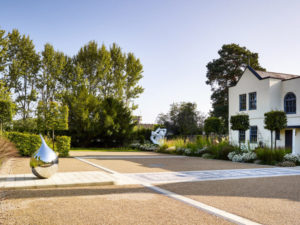
Sussex Garden is one of the Marian Boswall Landscape Architects studio’s projects. A lover of contemporary art, their client wanted to create a garden of vibrant colours and dramatic impact. The new entrance courtyard includes a Portuguese cobble tapestry leading to a striking sculpture to balance the entrance to the house.
Parking is screened from the house and generous planting provides a gracious entrance in keeping with the setting. The parkside garden was resculpted to include a ha-ha to link the garden to the fabulous views across the park.
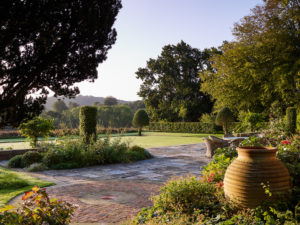
A reclaimed York stone entertaining terrace leads down to a sunken croquet lawn and wildflower meadow beyond. The orangerie garden is a contemporary interpretation of an historic parterre to be seen partly from above and also from within.

Bold sweeps of Rudbeckia, Helenium, Salvias, Agastache and Veronicastrum are punctuated with graceful grasses and spires to catch the evening light in Summer and Autumn. Winter frosts provide a fabulous structure of seedbeds and cobweb stems to tempt you into the garden, until a loud symphony of bulbs takes over in the Spring.
Recent podcasts are a Gardens Illustrated series, Season Two of Talking Gardens, which can be accessed at https://www.gardensillustrated.com/podcasts/talking-gardens-marian-boswall and Life Without Walls at https://podcasters.spotify.com/pod/show/caroline-jory. Spotify needed.
https://www.marianboswall.com/ Biographical information and photographs supplied by Marian Boswall.

Charlotte Harris
Charlotte Harris co-founded values-driven landscape design practice Harris Bugg Studio with Hugo Bugg in 2017. She has won three Gold Medals and a Best in Show at RHS Chelsea Flower Shows and been called a “pioneering design talent” by the RHS. Charlotte studied Landscape Design at Merrist Wood, and started her career working with Tom Stuart-Smith. She guest lectures; writes on design and planting; is one of six contributing editors to Garden Illustrated, and is a vocal advocate of better representation and diversity in the sector.
The Harris Bugg Studio is an award-winning landscape design practice with a team of landscape architects, garden designers and horticulturalists based between three studios in London, Devon and the Isle of Skye.
Understanding the spirit of place is central to the studio’s approach, and a careful selection of high-quality materials and elegant, intelligent planting palettes ensures gardens are contextual, graceful and made to last. Celebrating and amplifying a place is what makes a garden timeless, atmospheric, connected and charismatic. By ensuring each garden has many layers to peel back, both in the design and the planting, there is always something new to explore and enjoy, whatever the season.
Harris Bugg Studio’s projects range from large country estates to small private gardens and city roof terraces, many with conservation and heritage sensitivities. Working in the UK and internationally, current projects include rural and country estates in Dorset, Oxfordshire, Exmoor, the Highlands, the Isles of Skye and Harris as well as the Botanic Gardens of Gothenburg and commercial projects in London and Berlin. City projects include a roof terrace above a Covent Garden Theatre and a number of gardens in Kensington, Holland Park, Farringdon and Notting Hill, They have recently completed the redesign of the walled kitchen garden at RHS Garden Bridgewater.
A full-service studio highly experienced in both design and the skills that it takes to bring a project to life, Harris Bugg Studio works closely with landscape contractors, craftspeople, cost consultants, specialists and nurseries to ensure that work is delivered on time, to budget and to the exacting standards clients expect. Working closely with architects and other design professionals ensures harmonious, seamless connections between indoor and outdoor spaces. Once the garden is complete, the practice continues working with clients and their gardeners over the long-term to help a space evolve beautifully.
Intuitive, enthusiastic and extremely hard-working, within a short space of time Charlotte and Hugo have demonstrated their ability to deliver work at the highest level, being labelled “pioneering design talents of their generation” by the Royal Horticultural Society and “personable, meticulous and committed” by the National Trust.

© Martin Pope
Arabella Lennox-Boyd
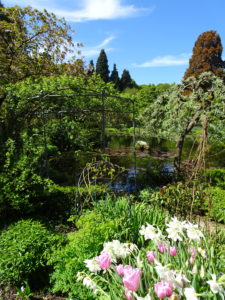
With no sign of slowing down, Lady Arabella Lennox-Boyd has created 800 gardens across the world for private clients, charities and gardens open to the public. Growing up in Italy but moving to London in the 1960s meant that both contrasting garden traditions have influenced her style.
She likes to be involved in the growing and developing of the gardens she designs: her hilltop family home near Rome Palazzo Parisi with its formal terraces and avenues of cypress and olives, and her own 10-acre gardens in a steep-sided valley at Gresgarth Hall in Lancashire, are still being renewed and added on. Gresgarth Hall includes formally clipped hedges, stone terraces and herbaceous borders framed by large grass areas giving way to a lake, stream & arboretum of rare plants.

Arabella was fortunate to make the acquaintance of influential garden and interior designer Nancy Lancaster (formerly Nancy Tree) which initiated her garden design career. In 1969, she began to study landscape architecture at Thames Polytechnic (now the University of Greenwich) and Arabella Lennox-Boyd Landscape & Architectural Design was founded in 1975. Her team now consists of independent landscape designers, landscape architects, architects and horticulturalists with shared beliefs, vision and ideas.
To commissions from all over the world have been added six Chelsea gold medals, trusteeship of Kew Gardens and the Chelsea Physic Garden, and among other accolades she received the Veitch Memorial Medal for her work in horticulture. And there are books: her fourth, Gardens in My Life (2021), comprises a tour of the 16 gardens that mean the most to her.
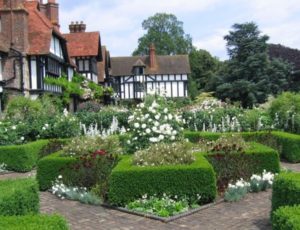
One particular connection to Bucks is Arabella’s work at Ascott House near Wing, the late C19th half-timbered house that contrasts greatly with other nearby Rothschild properties such as Waddesdon, Mentmore and Halton. In the private gardens on the terrace behind the house, yew and box topiary enclosing compartments of herbaceous plants and roses were used to convey a modern interpretation of a Victorian garden. Clearly there is not space to do it justice here! Amongst other features of the public areas, the best-known is the magnificent Madeira Walk, planted with old roses and sturdy herbaceous perennials.
Another and completely contrasting favourite is Andalusia, a 225-year-old Greek Revival House located on a wooded promontory overlooking the Delaware River just north of Philadelphia. It has been owned by generations of horticulturalists. Arabella was asked to expand the existing gardens in 2014, including a private pool garden, but also the public Green Walk, ‘Father’s Garden’ and riverside circular garden, serving the visitors’ centre, where visitors can meet. The Green Walk area was populated with a series of beautifully mature specimens of pink-flowered Cornus florida var. rubra and, beyond these, was a view of the river, which would influence Arabella’s design for all the garden areas. Beneath the Cornus, she created elegant borders of woodland plants. In the adjacent White Garden, she planted in shades of white, ivory and cream and, at the north end of the Green Walk, she playfully planted the top of the Ice House Mound with silvery Juniper, to give the impression of a snow-capped mountain. Arabella further contributed with a range of special trees and shrubs in Father’s Garden and, for the Meeting Rondel, where the river view dominates, Arabella was keen to simply skirt the existing trees with a tapestry of ground covers and low rhododendrons.make the most of the view. Excitingly, Arabella is now turning her attention to the landscape north and west of the house.
https://www.arabellalennoxboyd.com/

Jo Thompson
In three words what does gardening means to you? “Calm, uplifting, care.”
Jo Thompson is one of the UK’s leading and best-known garden designers. She has won four Gold and five Silver Gilt medals at Chelsea Flower Show, and won the coveted People’s Choice Award at the first RHS Chatsworth Show. She is known for creating private and public gardens that are sensitive to their location and history, as well as intelligently planted.
Much of Jo’s childhood was spent in Italy, firstly in Rome, then as a student in Venice, followed by long summers at the family’s Tuscan home nestled in the Sienese hills. The architecture and art of Italy inspires much of her work and her exquisite planting has led her to be considered one of the UK’s leading plantswomen. Current projects include the regeneration of the walled gardens at Water Lane in Kent, the planting surrounding a 16th Century house in Sussex, a roof garden in Rome and a naturalistic garden in Connecticut. She is also working with Gustafson Porter + Bowman on the restoration of Highgate Cemetery in London.
Jo speaks both nationally and internationally; she is a Fellow of the Landscape Institute, a Fellow of the Society of Garden Designers and a Trustee of Bankside Open Spaces Trust.
She has written two books including The Gardener’s Palette, which explores the use of colour to create atmosphere and year-round interest in every garden. Her third book, to be published in 2025, will look at the allure of romantic gardens. Her weekly Substack newsletter The Gardening Mind shares her insights about designing for all kinds of gardens.
www.jothompson-garden-design.co.uk
https://jothompson.substack.com

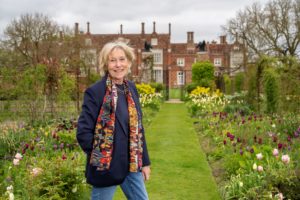
Xa Tollemache
Xa Tollemache is probably best known for the creation of the Grade I listed, 10 acre (4-ha) gardens at her spectacular moated and drawbridged Tudor home, Helmingham Hall in Suffolk. Starting in the 1970s when she knew nothing about gardening, Xa gradually developed the gardens to complement the grand formal elements of the topiary, formal hedges, parterres and surrounding deer park, with tunnels of sweet peas, vegetables among the roses, old orchards, long grass and wildflower meadows.
The expertise she acquired led her on to gold and silver-gilt medals at Chelsea, a wide range of both urban and rural garden commissions in Britain and abroad, and the Council of the RHS as well as serving on the herbaceous perennial committee and judging at RHS shows.
Examples of Xa’s versatility include the Global Growth Vegetable Garden at RHS Hyde Hall, an educational space incorporating crops that originate from different areas of the globe but are not generally associated with food in the UK even if grown as ornamentals.
In total contrast, at Wilton House (Wilts), a Tudor house – previously an abbey – rebuilt in the 1650s, the Cloister Garden in the central courtyard of the house was designed as a knot garden. This was based on a 17th-century account and used only box, cotton lavender and bay.
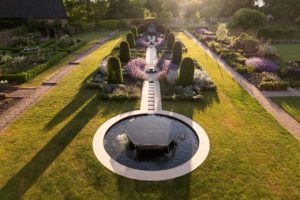
At Bramfield Hall in Suffolk Xa’s design incorporates a rill and pool where William Pye has contributed spectacular metal sculptures.
Different again, at Dunbeath Castle, Caithness, Xa remodelled a walled garden first laid out in 1860. She installed garden rooms with permanent structures, each providing a different service and personality. The Long Borders dissect the garden into four sections, each subdivided by ironwork arches providing working and decorative gardens.
Having recently handed over Helmingham Hall gardens to her son and daughter-in-law, she has branched out into garden furniture design, has designed a unique rose support system, and has documented her career in a book Xa’s book A Garden Well Placed: The Story of Helmingham and Other Gardens (2022), published by Pimpernel Press.
Helmingham Hall gardens are open Wednesday 1st May 2024 – Monday 30th September 2024, Mondays, Tuesdays, Wednesdays, Thursdays, Sundays and Bank Holidays 10:00am – 5:00pm. https://www.helmingham.com/
https://www.xa-tollemache.co.uk/
 Inspire & Inclusion is the focus for this International Women’s Day
Inspire & Inclusion is the focus for this International Women’s Day
The following quotations come from women who believed in women and their ability to achieve anything they wanted to.
- Well-behaved women rarely make history.” –Eleanor Roosevelt
- “Feminism isn’t about making women strong. Women are already strong. It’s about changing the way the world perceives that strength.” –G.D. Anderson
- “Every woman’s success should be an inspiration to another. We’re strongest when we cheer each other on.” –Serena Williams
- “Empowering women isn’t just the right thing to do, it’s the smart thing to do.” –Barack Obama
- “There is no force more powerful than a woman determined to rise.” –W.E.B. Dubois
- “There is no limit to what we, as women, can accomplish.” –Michelle Obama
- “I do not wish women to have power over men; but over themselves.” –Mary Shelley






